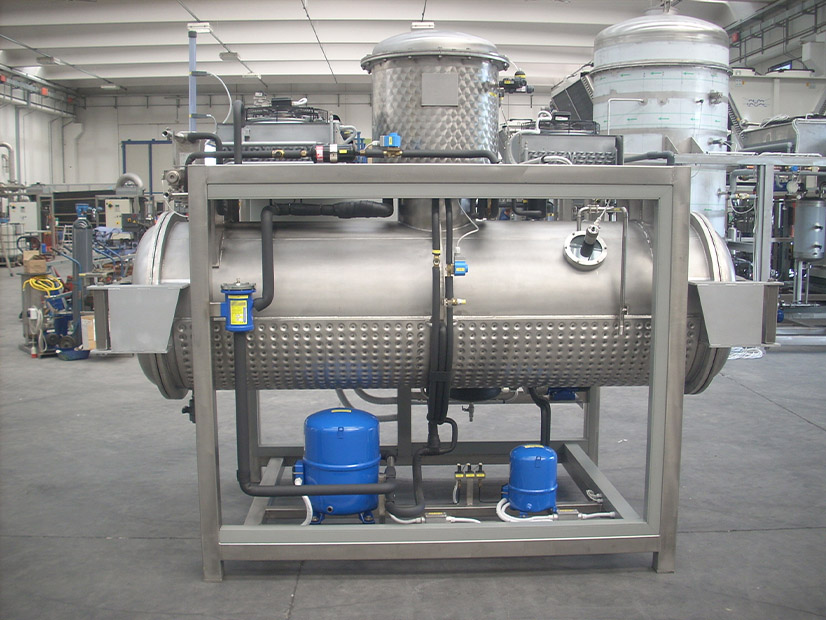The California Energy Commission (CEC) is exploring the use of heat pump technologies to accelerate decarbonization in the dairy sector, which accounts for 2.5% of the state’s energy consumption and 1.4% of greenhouse gas emissions.
Home to over 1,100 dairy farms and over 130 dairy product processing facilities, California leads the nation in milk production and is the second largest cheese producer. In 2020, the U.S. dairy industry announced a goal of net zero carbon emissions by 2050, and commissioners identified that transitioning from thermal resources to heat pump technologies for processes like pasteurization, evaporation and cleaning could lead to significant energy savings while reducing reliance on fossil fuels.
“Knowing how important the dairy sector is to California’s economy and knowing we could bring some innovation to the sector, [we can] really work together with industry to improve the carbon footprint,” CEC Commissioner Andrew McAllister said during an Aug. 29 meeting to discuss decreasing dairy emissions.
Through the Food Production Investment Program, the CEC has awarded up to $117.8 million in grants to help food producers reduce greenhouse gas emissions, including to six California dairy facilities.
“These projects have or will improve operation efficiency and lower production costs, and in general maintained or increased the quality and quantity of production,” said Matthew Stevens, a CEC staffer representing the Food Production Investment Program. “We have done a lot of waste heat capture and storage, general system overhauls, and recently, we’re tackling to replace very inefficient, aging, high global warming refrigeration systems.”
‘Where Everybody Wins’
Several experts who focus on the decarbonization of industrial facilities presented at the meeting, all highlighting the potential for heat pumps to improve energy efficiency in the dairy sector.
Dr. Ahmad Ganji, director of San Francisco State University’s Industrial Assessment Center (IAC), said there are “significant opportunities for energy efficiency in dairy processing plants,” with efficiency increases of at least 10-15%. The IAC analyzes and informs industrial facilities about how they can decarbonize, and Ganji said it plans to recommend heat pump technologies at dairy processing plants as the technology improves.
Most of the emissions from dairy processing facilities come from natural gas-powered steam boilers used for pasteurization and other processes requiring heat, according to Arun Gupta, CEO of Skyven Technologies.
“Twenty percent of global carbon emissions are caused by industrial heat, which, for context, is about as much carbon impact as all of transportation, all of the cars, trains, planes, boats, everything combined,” Gupta said. “Half of that is steam, so steam is enormous.”
Skyven developed a new steam-generating heat pump technology, designed for use in dairy processing plants, that can generate steam for heating and cooling at lower prices than boilers that run on natural gas.
“That allows us to achieve the deep decarbonization that the industry is looking for,” he said. “Decarbonization solutions must be cost competitive with existing boilers and, better than cost competitive, they actually need to save money … Where everybody wins is where decarbonization and cost savings go hand-in-hand.”
Skyven was recently awarded a $145 million grant from the U.S. Department of Energy to deploy steam-generated heat pumps across multiple manufacturing sectors, including California dairy facilities, with the goal to make the technology an industry standard. Gupta estimated the project will cut GHG emissions by around 400,000 metric tons, produce 1,000 jobs and benefit over 300,000 people through cleaner air.
Curtis Rager, product manager at Johnson Controls, provided additional background on how heat pumps could increase the efficiency of refrigeration systems at dairy facilities. Most dairy plants use ammonia as a refrigerant that is pumped throughout the system and absorbed at the point of use.
For example, refrigerant is sent to milk silos which absorb heat that then flows through the system and is discharged into the atmosphere via evaporative condensers. The process of heating milk up for pasteurization and then cooling it back down requires a lot of heat usage, and pumps could help offset discharged waste heat.
“[Heat pumps are] capturing that ammonia refrigeration gas steam that’s going to the evaporative condenser and it’s now taking that and it’s going through another stage of compression,” Rager said. “With a second stage of compression in the heat pump portion you can pump up that temperature … and now through the condenser, you can bring the cold water in and produce hot water all from the energy that was absorbed … from those evaporators.”
The system would allow for significant energy- and water-use savings, contributing to Gupta’s goal of simultaneous decarbonization and reduction of costs.
“We believe that steam decarbonization is crucial for the decarbonization of the industry, and this technology allows that to happen in a way that is profitable for manufacturers and allows them to achieve both the savings and the carbon reductions that they’re looking for,” Gupta said.


